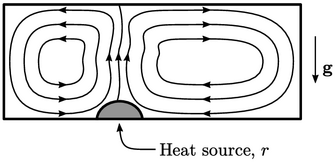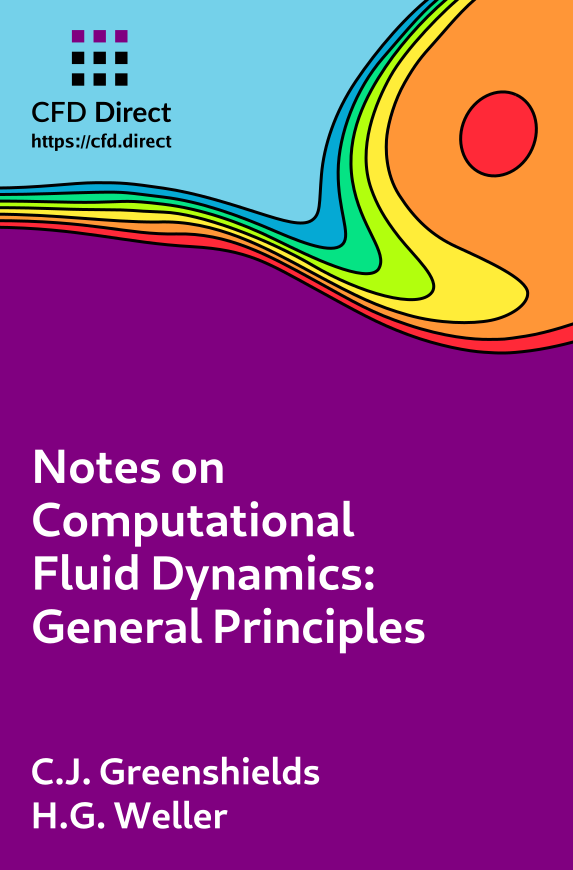2.20 Natural convection
In Sec. 2.13 , a set of equations — Eq. (2.47 ) and Eq. (2.48 ) — was derived for flow of an incompressible fluid. They are a sample set of equations for mass and momentum conservation that can be solved using methods described in this book.
The example set of equations can be extended to include energy conservation and associated models of heat conduction and heat capacity, described in Sec. 2.15 - 2.18 .

The set of equations for mass, momentum and
energy can be combined to simulate natural convection, e.g. for flow of air around a room. In
natural convection, a non-uniform temperature causes density
variations which generate associated forces due to gravity. Colder
air is driven downwards and hot air rises, creating buoyancy. Small
temperature variations, e.g. due to a heat source  , can cause
buoyancy to be the dominant force.
, can cause
buoyancy to be the dominant force.
A simple, approximate equation for  can be derived,
starting from internal energy conservation in the form of
Eq. (2.57
). The
approximations of constant
can be derived,
starting from internal energy conservation in the form of
Eq. (2.57
). The
approximations of constant  (with
(with  ) and zero viscosity
reduce the stress/pressure work terms to zero.
) and zero viscosity
reduce the stress/pressure work terms to zero.
Assuming  constant, we can apply
Eq. (2.63
), which reduces to
substituting
constant, we can apply
Eq. (2.63
), which reduces to
substituting  by
by  since derivatives of constants
since derivatives of constants  and
and  are zero. Applying
Fourier’s law Eq. (2.54)
leads to
are zero. Applying
Fourier’s law Eq. (2.54)
leads to
 |
(2.65) |
 and
and  becomes a thermal source in SI units of
becomes a thermal source in SI units of
 .
.
This is another example, similar to
Eq. (2.49
), of a
transport equation containing a time
derivative, advection, diffusion and a source of heat. Applying
suitable boundary conditions, the equation can be solved for
 .
.
Buoyancy force
The effect of buoyancy can be simulated by
setting the body force  in Eq. (2.47
) for an
incompressible, Newtonian fluid. While the assumption
in Eq. (2.47
) for an
incompressible, Newtonian fluid. While the assumption  constant
is applied across all the governing equations generally, it cannot
be applied to this force. Therefore we apply
constant
is applied across all the governing equations generally, it cannot
be applied to this force. Therefore we apply
 |
(2.66) |
 is a density at a reference state, e.g. at the initial
is a density at a reference state, e.g. at the initial  and
and  , and
, and  is the
acceleration due to gravity.
is the
acceleration due to gravity.
The density  is a function of
is a function of
 and, optionally,
and, optionally,  provided by some equation of state, e.g. the ideal gas Eq. (2.55
). The final momentum equation
including this buoyancy force, and assuming
provided by some equation of state, e.g. the ideal gas Eq. (2.55
). The final momentum equation
including this buoyancy force, and assuming  constant is:
constant is:
 |
(2.67) |

